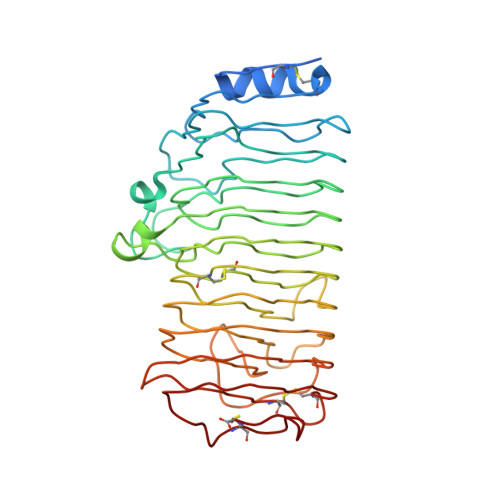1.68-A crystal structure of endopolygalacturonase II from Aspergillus niger and identification of active site residues by site-directed mutagenesis.
van Santen, Y., Benen, J.A., Schroter, K.H., Kalk, K.H., Armand, S., Visser, J., Dijkstra, B.W.(1999) J Biological Chem 274: 30474-30480
- PubMed: 10521427
- DOI: https://doi.org/10.1074/jbc.274.43.30474
- Primary Citation of Related Structures:
1CZF - PubMed Abstract:
Polygalacturonases specifically hydrolyze polygalacturonate, a major constituent of plant cell wall pectin. To understand the catalytic mechanism and substrate and product specificity of these enzymes, we have solved the x-ray structure of endopolygalacturonase II of Aspergillus niger and we have carried out site-directed mutagenesis studies. The enzyme folds into a right-handed parallel beta-helix with 10 complete turns. The beta-helix is composed of four parallel beta-sheets, and has one very small alpha-helix near the N terminus, which shields the enzyme's hydrophobic core. Loop regions form a cleft on the exterior of the beta-helix. Site-directed mutagenesis of Asp(180), Asp(201), Asp(202), His(223), Arg(256), and Lys(258), which are located in this cleft, results in a severe reduction of activity, demonstrating that these residues are important for substrate binding and/or catalysis. The juxtaposition of the catalytic residues differs from that normally encountered in inverting glycosyl hydrolases. A comparison of the endopolygalacturonase II active site with that of the P22 tailspike rhamnosidase suggests that Asp(180) and Asp(202) activate the attacking nucleophilic water molecule, while Asp(201) protonates the glycosidic oxygen of the scissile bond.
- Laboratory of Biophysical Chemistry, Groningen University, 9747 AG Groningen, The Netherlands.
Organizational Affiliation:


















